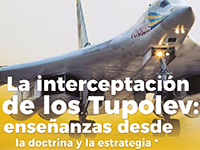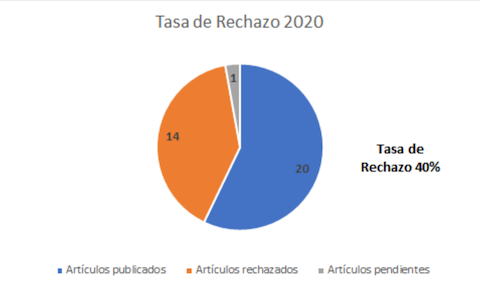A intercetação dos Tupolev: ensinos desde a doutrina e a estratégia
DOI:
https://doi.org/10.18667/cienciaypoderaereo.635Palavras-chave:
estratégia, Tupolev, desvantagem assimétrica, capacidades militaresResumo
No dia 1 de novembro de 2013 dois aviões russos tipo Tupolev, entre eles o bombardeiro nuclear mais rápido do mundo, ingressaram sem prévia autorização sobre espaço aéreo nacional da Colômbia. O processo de interceptação e a tomada de decisões ao nível estratégico deixaram desde a teoria de Colin S. Gray, reflexões e ensinos necessários para seguir evoluindo o processo de tomada de decisões no interior do país e manter a importância da estratégia no uso do poder aéreo. Os ensinos derivados de dita experiência, em particular, permite a Colômbia refletir sobre como administrar uma desvantagem assimétrica diante dos seus adversários. Também reconhecer que as decisões militares não são as únicas determinantes da estratégia, senão também, a vontade política, o compromisso de uma nação e a consciência pela defesa do país.
Downloads
Referências
Barry R. Posen (2003). Command of the Commons: The Military Foundation of US Hegemony, International Security, Vol. 28, No. 1 (Summer 2003), pp. 5-46. https://doi.org/10.1162/016228803322427965
Boyne, W. J. (2002). Air Warfare: An International Encyclopedia, Abc-clio.
Bukharin, O. (2004). Russian strategic nuclear forces, MIT Press.
Buzan, B. (1996). The timeless wisdom of realism. International theory: positivism and beyond, 47-65. https://doi.org/10.1017/CBO9780511660054.004
Buzan, B., & Hansen, L. (2009). The Evolution of International Security Studies. Political Science. https://doi.org/10.1017/CBO9780511817762
Buzan, B., Wæver, O., Wæver, O., & De Wilde, J. (1998). Security: a new framework for analysis. Lynne Rienner Publishers.
Camargo, P. P. (1984). La Convención sobre el derecho del mar: (texto y comentarios). Editorial Temis Librería.
Castro, C. A. A. and C. A. P. Herrera (2014). Reflexiones sobre la guerra de cuarta generación, una visión desde los actores sin recursos de poder en términos tradicionales. Ciencia y Poder Aéreo 9 (1): 79-87. https://doi.org/10.18667/cienciaypoderaereo.136
Chairman Mao,"The Chinese People Cannot be Cowed by the Atom Bomb," and"S.Imperialism is a Paper Tiger," in Selected Works of Mao Tse-tung, vol. 5, 152-53, 308-311
CNN. (2013). Colombia denuncia que dos bombarderos rusos violaron su espacio aéreo.
Council, N. R. D. (2006). Russian nuclear forces, 2006. Bulletin of the Atomic Scientists, 62 (2), 64-67. https://doi.org/10.1080/00963402.2006.11460975
Creveld, M. van. (1991). The transformation of war. New York: Free Press.
Douhet, G. (2009). The command of the air. University of Alabama Press.
Ehrlich, H. J., & Note, A. P. (1996). Anarchism and formal organization. Reinventing anarchy, again, 56-68.
Gladwell, M. (2013). David and Goliath: Underdogs, misfits, and the art of battling giants. Hachette UK.
Gray, C. S. (2012). The Airpower Advantage in Future Warfare: The Need for Strategy, Lulu. com.
Gray, C. S. (2015). Strategic Studies and Public Policy: The American Experience. University Press of Kentucky.
Hollis, M. (1990). Explaining and understanding international relations.
Holsti, K. J., & Holsti, K. J. (1996). The state, war, and the state of war (No. 51). Cambridge University Press. https://doi.org/10.1017/CBO9780511628306
Jeremi S. (2003). Power and Protest: Global Revolution and the Rise of Détente. Cambridge, Massachusetts: Harvard University Press, pp. 1-87
Jervis, R. (1986). Cognition and political behavior. Political cognition, 319-336.
Kennan, G. F. (1947). Memoirs, 1925-1950. Boston, 1967. For the Press. May, 7, 1.
Kenneth, W. (1959). Man, the State and War. A theoretical analysis. New York: Columbia University Press.
Lieber, K. A., & Press, D. G. (2006). The end of MAD? The nuclear dimension of US primacy. International Security, 30(4), 7-44. https://doi.org/10.1162/isec.2006.30.4.7
Lüthi, L. (2008). The Vietnam War and China's Third-Line Defense Planning before the Cultural Revolution, 1964-1966. Journal of Cold War Studies, 10(1), 26-51. https://doi.org/10.1162/jcws.2008.10.1.26
Morgenthau, H. (1948). 1978. Politics among nations: The struggle for power and peace. New York: Alfred S. Knopf.
Nye Jr, J. S., & Lynn-Jones, S. M. (1988). International security studies: a report of a conference on the state of the field. International Security, 12(4), 5-27. https://doi.org/10.2307/2538992
Riquelme-Cortado, R. M. (1985). Reflexiones sobre la firma y la ratificación de la Convención de las Naciones Unidas sobre el Derecho del Mar (1982). A propósito de la firma por España.
Shang, C. (2011). Dancing with his "Lesser Evil"-Mao's China from 1962-68 and the road to rapprochement with the United States. University of Arkansas.
Skinner, Q. (1978). The Foundations of Modern Political Thought. The Age of Reformation (Vol. 2). Cambridge University Press.
Smoke, R. (1975). National Security Affairs. Hand- book of Political Science, 8, 247-362.
Terriff, T., Croft, S., James, L., & Morgan, P. (2000). Security studies today. Polity.
Trest, W. A. (1998). Air Force Roles and Missions: A History. Government Printing Office. https://doi.org/10.21236/ADA476260
Tse-Tung, M. (2014). Selected works of Mao Tse-tung (Vol. 5). Elsevier.
Waltz, K. N. (1988). The origins of war in neorealist theory. The Journal of Interdisciplinary History 18(4): 615-628. https://doi.org/10.2307/204817
Waltz, K. (1979). Theory of international politics: reading. University of California, Berkeley: Addison-Wesley Publishing Company, In.
Wohlforth, W. C. (1993). The elusive balance: power and perceptions during the Cold War. Cornell University Press.
Wolfers, A. (1952). "National security" as an ambiguous symbol. Political Science Quarterly, 67(4), 481-502 https://doi.org/10.2307/2145138

Downloads
Publicado
Edição
Seção
Licença
Copyright (c) 2021 Escuela de Postgrados de la Fuerza Aérea Colombiana

Este trabalho está licenciado sob uma licença Creative Commons Attribution 4.0 International License.
Declaração de cessão de direitos autorais à revista
O autor cede exclusivamente à Revista os direitos de exploração (reprodução, distribuição, comunicação pública e transformação) para explorar e comercializar a obra, no todo ou em parte, em todos os formatos e modalidades de exploração presentes ou futuros, em todas as línguas, por todo o período de vida da obra e pelo mundo inteiro.
Todo o conteúdo publicado na revista científica Ciencia y Poder Aéreo está sujeito à licença de reconhecimento internacional Creative Commons 4.0, cujo texto completo pode ser encontrado em http://creativecommons.org/licenses/by/4.0/
A licença permite que qualquer usuário baixe, imprima, extraia, arquive, distribua e comunique publicamente este artigo, desde que seja dado o devido crédito aos autores: ao(s) autor(es) do texto e a Ciencia y Poder Aéreo, Revista da Escola de Pós-Graduação da Força Aérea Colombiana. Exceto quando for indicado o contrário, o conteúdo deste site será licenciado sob uma licença Creative Commons Attribution 4.0 Internacional.
Para usos de conteúdo não previstos nestas normas de publicação é necessário entrar em contato diretamente com o diretor ou editor da revista através do e-mail cienciaypoderaereo1@gmail.com
A Escola de Pós-Graduação da Força Aérea Colombiana e esta revista não são responsáveis pelos conceitos expressos nos artigos, nem pelos metadados fornecidos ou pelas afiliações que os autores declarem, sendo assim de inteira responsabilidade dos autores.

Licença Creative Commons
Os autores concedem à revista os direitos de exploração (reprodução, distribuição, comunicação pública e transformação) para explorar e comercializar a obra, inteira ou parcialmente, em todos os formatos e modalidades de exploração presentes ou futuras, em todas as línguas, por todo o período de vida da obra e no mundo inteiro.
Todos os conteúdos publicados na revista científica Ciencia y Poder Aéreo estão sujeitos à licença de reconhecimento 4.0 4.0 Internacional de Creative Commons, cujo texto completo pode-se consultar em http://creativecommons.org/licenses/by/4.0/
A licença permite a qualquer usuário baixar, imprimir, extrair, arquivar, distribuir e comunicar publicamente um artigo, desde que seja dado crédito aos autores do trabalho: aos autores do texto e a Ciencia y Poder Aéreo, Revista Científica da Escola de Pós-Graduação da Força Aérea Colombiana. Salvo onde for indicado o contrário, o conteúdo deste site é licenciado sob uma licença Creative Commons Atribución 4.0 internacional.
Para usos de conteúdo não previstos nestas normas de publicação é necessário entrar em contato diretamente com o diretor ou editor da revista através do e-mail cienciaypoderaereo1@gmail.com
A Escola de Pós-Graduação da Força Aérea Colombiana e esta revista não são responsáveis pelos conceitos expressos nos artigos, nem pelos metadados fornecidos ou pelas afiliações que os autores declarem, sendo assim de inteira responsabilidade dos autores.




















